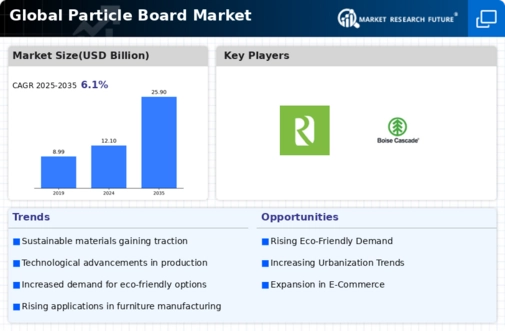Top Industry Leaders in the Particle Board Market
 The particle board market hums with a dynamic interplay of established giants and nimble regional players. Understanding this competitive landscape is crucial for navigating its complexities and seizing profitable opportunities. This comprehensive analysis delves into the key strategies, market share determinants, industry news, and recent developments shaping the particle board world.
The particle board market hums with a dynamic interplay of established giants and nimble regional players. Understanding this competitive landscape is crucial for navigating its complexities and seizing profitable opportunities. This comprehensive analysis delves into the key strategies, market share determinants, industry news, and recent developments shaping the particle board world.
Strategies for Market Domination:
Product Diversification: Leading players like West Fraser and Georgia-Pacific offer a diverse range of particle boards, catering to various applications like furniture, flooring, and cabinets. This strategy caters to specific needs and expands customer base.
Sustainability Focus: With environmental concerns rising, sustainable particle boards made from recycled wood or agricultural waste are gaining traction. Companies like Kronospan and Egger are investing heavily in eco-friendly production, attracting environmentally conscious consumers.
Technological Innovation: Automation and advanced manufacturing processes are being implemented to improve efficiency, reduce costs, and enhance product quality. For example, Kastamonu Entegre's continuous press technology optimizes production, giving them a competitive edge.
Geographic Expansion: Established players like Roseburg Forest Products are entering new markets, particularly in Asia-Pacific, driven by its high growth potential. This strategy leverages existing expertise and expands reach.
Strategic Acquisitions and Partnerships: Mergers and acquisitions are consolidating the market, while partnerships with furniture manufacturers and distributors are creating a strong value chain. For instance, Wanhua Ecoboard's acquisition of Norbord significantly boosted its market share in North America.
Factors Influencing Market Share:
-
Production Capacity: Companies with large production facilities like Kronospan and Pfleiderer have a cost advantage and can cater to bulk orders, securing market share. -
Brand Reputation: Established brands like IKEA and Lowe's with strong brand recognition have a loyal customer base, influencing the particle board market they source from. -
Product Quality and Price: Offering high-quality boards at competitive prices is crucial for attracting and retaining customers. Companies like Tafisa excel in this area, gaining market share through value proposition. -
Distribution Network: An efficient distribution network ensures timely delivery and lower costs. Companies like Ainsworth Lumber have invested heavily in logistics, providing a competitive edge. -
Government Regulations: Environmental regulations and formaldehyde emission standards can impact production costs and market share. Companies like Greenpanel are leading the way in developing compliant and sustainable particle boards.
List of the Key Companies in the Global Particle Board Market are
Timber Products Company
Roseburg, Uniboard
Dakota Premium Hardwoods
Associate Decor Limited
Boise Cascade, D&R Henderson Pty Ltd
Green Land Particle Board
Century Plyboards India Ltd
Krifor Industries
Shell Laminates Pvt. Ltd
DMK Particleboard LLP
Kunnathan Chip Board Pvt. Ltd
Action TESA
FA Mitchell.
Recent Developments:
-
August 2023: The impact of the COVID-19 pandemic continues to linger, with construction activity in some regions still recovering. This affects demand for particle boards, which are heavily used in construction. -
September 2023: The rising cost of raw materials like wood chips and resins puts pressure on manufacturers, potentially leading to price increases for particle boards. -
October 2023: Focus on sustainability gains momentum, with manufacturers exploring eco-friendly alternatives like recycled wood and agricultural residues for particle board production. -
November 2023: Technological advancements in binding agents and production processes offer opportunities for improved product quality and efficiency.

